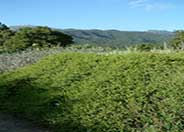
Common name:Coast Live Oak
Botanical name:Quercus agrifolia
Coast Live Oak (Quercus agrifolia) is one of the best trees for California native or California-friendly gardens. It grows very well from the coastal areas to the interior valleys. It is an evergreen tree that can reach 25’-70' tall and up to 70' wide, so make sure you have the space in your garden to support it. It is considered very low-water-use and is susceptible to root rot in gardens that are over-irrigated. Plant it with other California natives or low-water plants and stick to a watering cycle that includes watering during the fall, winter, and spring with no supplemental water in the summer. The tree is a slow grower and has an irregular shape when it is young, so it is important to make minimal pruning cuts to improve the look of the canopy. Over-pruning or hedging can take years to recover from, so consult or hire a licensed arborist when the shaping becomes out of your reach. This tree will eventually become a large shade tree; therefore, the plant selection around it may need to be adjusted as it matures. This tree should be planted at least five feet away from any hardscape areas, 20 feet from structures such as houses and buildings, and not near any powerlines. Shrubs and perennials should be planted about four feet away from this tree. It should be irrigated for about 45 minutes once a week when using most in-line drip irrigation systems.

Common name:California Poppy, Golden Poppy
Botanical name:Eschscholzia californica
This small annual (sometimes acts as a perennial) plant will grow to less than 1' tall and has light, small blue green leaves with gold and orange flowers that bloom in spring and summer.

Common name:Deer Grass
Botanical name:Muhlenbergia rigens
The Deer Grass is a warm season perennial that forms dense clumps from the base. The spike-like flower stalks grow 3' tall and this grass has striking foundation form. The Deer Grass is native to California and needs watering once or twice a month after it has been established. The more water it has, the greener it is.
Maintenance Tips
Muhlenbergia rigens is a dense grass with a dome-shaped structure arching in all directions. It is commonly referred to as Deergrass. The foliage can reach 3' tall and 5' wide with flower blooms that emerge in the spring and summer 18" above the foliage. This grass requires almost no maintenance if it is planted in its ideal conditions. A sunny location, well-drained soil, and the space to reach its mature size will ensure that it thrives without having to prune for size or shape. It is common to cut back perennial grasses very hard in the winter to prune off the old spent flowers. If you are planning on winter pruning, it is best to wait until you see some new foliage emerge so the newly emerging leaves can cover the cuts quickly.
Common name:Dwarf Coyote Bush
Botanical name:Baccharis pilularis
The pilularis is a low maintenance, reliable evergreen ground cover. It benefits from pruning in the spring. However, the cottony seeds from the female plant can be messy.

Common name:California Sycamore
Botanical name:Platanus racemosa
The California Sycamore is a fast growing deciduous tree that reaches up to 40'-50' high. It tolerates heat, smog, and drought conditions as well as moist conditions; it is native to riparian areas. It has interesting mottled bark when the tree is bare in winter.

Common name:Cedros Island Verbena
Botanical name:Verbena lilacina 'De La Mina'
Verbena lilacina 'De La Mina' is a selection introduced by the Santa Barbara Botanical Garden. It follows the same wonderful characteristics described under the general species V. lilacina.
Maintenance Tips
Verbena lilacina ‘De La Mina’ is a popular hybrid of the low-growing, herbaceous perennial that is native to a small island off the coast of Baja California. This variety grows 2-6' tall and 3-4' wide with dark purple flowers and a slight fragrance. This is a low-water, low-maintenance plant that rarely requires attention, pruning, or fertilizer. The best way to keep it looking and performing its best is to plant it in a sunny location with well-drained soil and to not overwater in the warmer months. During the fall and winter, the plant usually stops blooming and can sometimes look a little rangy. This is a good time to prune the plant to allow it some dormancy before the growth season begins again in the spring. You can cut back the foliage by one-third of the current size and remove any additional branches that have died back.
Common name:White Sage, Sacred White Sage
Botanical name:Salvia apiana
This woody shrub has long stems with silvery white leaves and fragrant white flowers that bloom in the spring. It provides a strong structural form as a garden focal point. It can reach 6' tall and 6' wide.
Designer: Bill Butler
Photographer: GardenSoft
Incorporate compost 6" into your soil to retain water, reduce compaction, feed earthworms, and provide valuable nutrients to your plants.
Remove irrigation water and fertilizer from areas where you don't want weeds to grow.